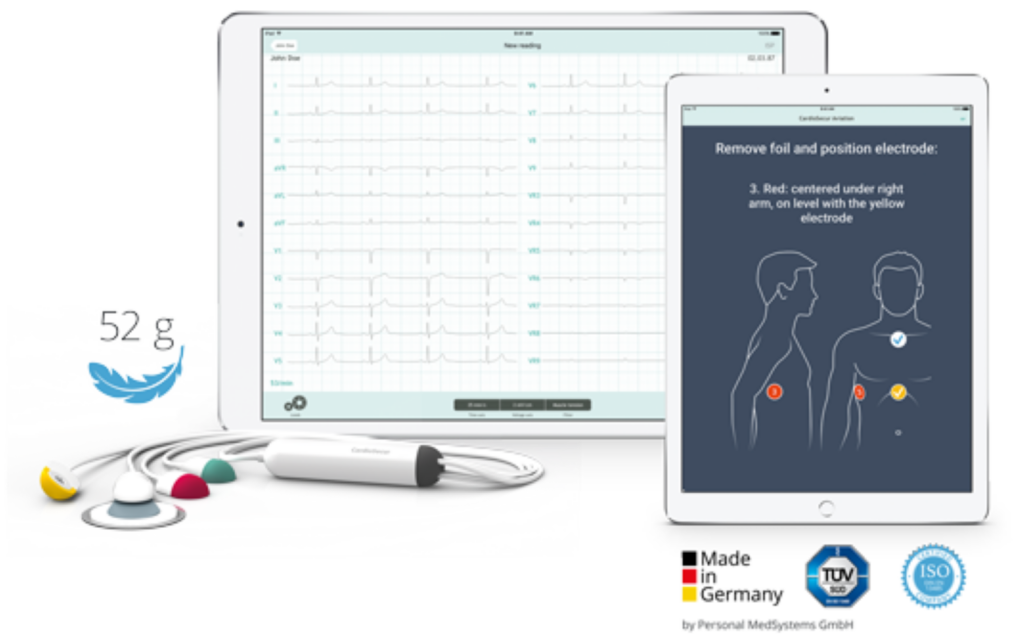While onboard health and wellness sees a renaissance in terms of the food, beverages and other soft product served on board, a key part of the health element is the medical technology provided by the airline for flight attendants — and any possible medical staff travelling on the aircraft — to use in the event of medical emergencies during the flight.
A key part of this medical toolbox is an electrocardiogram (ECG) machine. Virgin Atlantic, the first airline to have its fleet fully equipped with ECG machines, is now flying with a new, upgraded mobile ECG kit from German med-tech supplier CardioSecur, which integrates the kit with crew onboard tablets and inflight connectivity.
“The size of onboard kit has vastly reduced: the kit is 50 grams,” Linda Porter, senior manager for health at Virgin Atlantic, tells Runway Girl Network. “It also benefits from being futureproof and adaptable as our needs change. Another critical benefit is the training required for competent use by our cabin crew is minimal — four minutes online.”
The ECG kit uses vectorcardiography, and is able to perform a full twelve-lead analysis with only four electrode pickup points on the body. The system is designed to be applied under a layer of clothing without requiring chest garments to be removed entirely — reassuring for most, but particularly relevant within cultures where clothing standards mean that undressing would add stress — and it’s clear where the colour-coded electrodes are intended to attach.
“The 12-lead ECG is the gold standard for ECG diagnosis and is used for both resting and stress ECGs,” notes CardioSecur. “With the 12-lead ECG fundamentally all heart activity can be measured, and both rhythmic and ischemic abnormalities can be diagnosed on the anterior heart wall.”
The kit is controlled via an app, installed via mobile device management on all cabin crew iPads and iOS devices. The electrode lead connects to the crew device via a USB-C connector and doesn’t itself require batteries. Once plugged in, analysis and results can be transmitted over wireless inflight Internet to the airline’s partner ground based medical service, and is specially designed for low-bandwidth environments. CardioSecur gives a 350kb size for an average ECG, a fraction of the size of the average modern smartphone image posted on passengers’ socials.
Data from Virgin Atlantic shows that cardiovascular problems are the single most common reason that flights divert as the result of medical emergencies, making the addition of latest-generation heart-monitoring ECGs not just a benefit for passengers (or indeed crew) who might experience the medical event, but for the airline’s operations and costs as well.
“Virgin Atlantic was the first airline in the world to equip its whole fleet with a fully integrated telemedicine system in 2008,” Porter explains. We were then partnered with Remote Diagnostic Technologies, a Basingstoke-based company. We invested in the first three generations of Tempus: Tempus 2000, Tempus IC and Tempus IC2. We had great success with this system, saving many lives and halving our diversion rate for medical events. Our business needs changed and also telemedical technology advanced, so in 2022 we made the transition to move to a software based twelve-lead ECG solution — a full system change without any patient safety or quality compromise.”
With more older passengers travelling, and indeed with the additional stresses placed on the human body as flight times creep seemingly inexorably upwards, integrating this kind of technology within the cabin environment will be increasingly important, both for passenger wellbeing and for the airline’s operations.
Related Articles:
- SIA teams with Golden Door to enhance wellness on ULR flights
- Inflight Dublin launches wellness app to help passengers breathe easy
- Lufthansa on wellness applications – what about the liability?
- Press Release: Qantas reveals world-first wellbeing zone for A350
Featured image credited to John Walton











